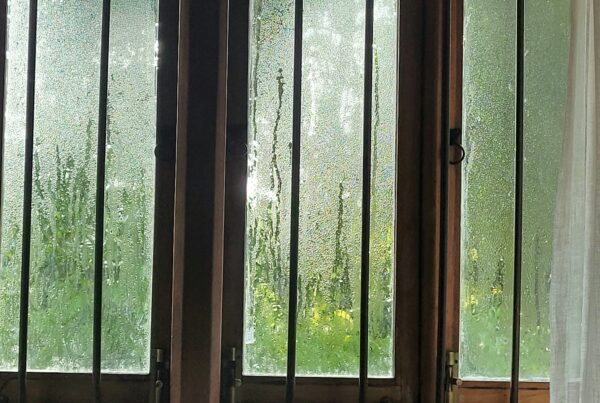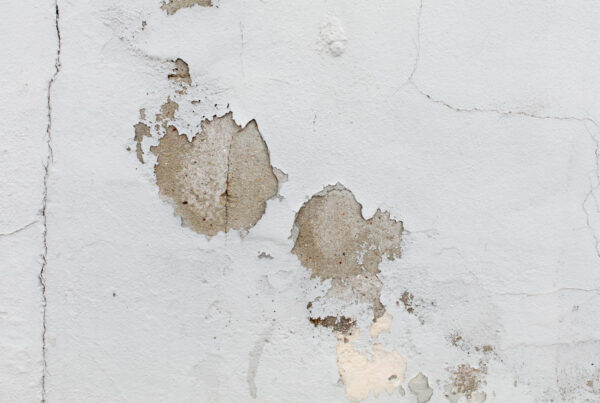Waking up to streaming windows and damp patches in room corners is a sign that your home struggles with excess moisture, which can lead to musty smells and damaging black mould. Condensation problems affect countless UK households, but smart prevention strategies can rebalance moisture levels and create healthy living conditions.
In this article, discover 10 practical condensation treatment methods, learn targeted prevention techniques, understand when professional help is needed, and master daily habits that help remove condensation problems permanently.
Why Does Condensation Develop in UK Homes?
Condensation forms when warm, moist air meets cold surfaces, creating water droplets that accumulate on windows, walls, and other cool areas. This moisture imbalance occurs when three factors combine: excess humidity from daily activities, inadequate ventilation to remove moist air, and cold surfaces that create the ideal conditions for water vapour to condense.
Modern UK homes with improved insulation but insufficient ventilation may experience condensation problems. Daily activities like cooking, showering, and drying clothes release water vapour that accumulates when suitable air circulation is absent. Understanding these causes helps you target the most effective condensation treatment approaches and implement smart prevention strategies.
10 Smart Ways to Prevent Home Condensation
Smart condensation prevention focuses on efficient, targeted methods that rebalance moisture, ventilation, and temperature throughout the home. These proven strategies address root causes while fitting seamlessly into daily routines.
1. Heat Your Home Smarter, not Harder
Consistent low-level heating is often more effective than short, powerful heating bursts for preventing condensation formation on cold surfaces. Maintain steady background temperatures rather than allowing your home to become cold between heating cycles. This keeps external walls above the dew point where condensation forms.
2. Rethink Your Laundry Routine
Drying wet clothes on radiators is a prevalent cause of excess household moisture, effectively running a humidifier throughout your living space. Smart alternatives include drying clothes outside when possible, using vented tumble dryers that expel moisture outdoors, or confining indoor drying to one room with the door closed and a dehumidifier running.
3. Master the 15-Minute Purge Ventilation Technique
Rapid air exchange through the strategic opening of windows creates effective ventilation than leaving windows slightly open all day. Open windows wide on opposite sides of your home for 10-15 minutes each morning to create cross-ventilation that flushes out humid overnight air without cooling your home’s structure.
4. Give Furniture Breathing Space
Cold, stagnant air pockets behind furniture are prime locations for the formation of condensation and potential mould growth. Pull sofas, wardrobes, and bookcases several inches away from external walls to allow for enough air circulation and prevent cold, humid microclimates where moisture readily condenses.
5. Apply Useful Kitchen Moisture Habits
Smart cooking practices can drastically reduce the production of steam and prevent humidity from the kitchen from spreading throughout your home.
Important kitchen condensation prevention techniques:
- Cover pots and pans whilst cooking – This reduces the release of steam into your kitchen atmosphere
- Use extractor fans consistently – Run kitchen extraction during cooking and continue for 10-15 minutes afterwards
- Keep kitchen doors closed – Contain moisture within the kitchen to prevent humid air from spreading
- Wipe down wet surfaces immediately – Remove moisture from worktops and appliances before it evaporates
- Check for appliance leaks regularly – Address dishwasher, washing machine, or pipe leaks that contribute to hidden moisture
6. Deploy Dehumidifiers Strategically for Maximum Impact
Dehumidifiers should be placed strategically to target moisture at its source instead of attempting to dry an entire property. They should be placed in high-moisture zones like bathrooms after showers, utility rooms where laundry dries, or bedrooms with condensation problems. Some modern models include timer functions or laundry modes that optimise performance.
7. Activate Your Windows’ Secret Ventilation System
Most modern uPVC windows include trickle vents – small, adjustable openings at the top that some homeowners don’t realise exist. Check window frames for these discrete vents and make sure they stay open to provide constant, secure background ventilation without compromising security or creating draughts.
8. Implement the Daily Squeegee and Cloth Routine
Proactive moisture removal prevents water accumulation that could evaporate and contribute to humidity problems or cause surface damage. Spend 30 seconds each morning using a squeegee on shower screens and wiping window panes with microfiber cloths to remove overnight condensation.
9. Target Problem Areas With Anti-Condensation Paint
Anti-condensation paint provides targeted treatment for persistent cold spots like bedroom corners or areas behind furniture where standard solutions fail. This specialised paint contains glass microspheres that create thermal barriers, making wall surfaces feel warmer and reducing the formation of condensation.
10. Conduct a Thorough Insulation Audit
Long-term condensation prevention efforts require addressing the underlying temperature differential that creates condensation conditions throughout a property.
key insulation assessment areas:
- Loft insulation depth – Current UK guidelines recommend 270mm depth for optimal thermal performance
- Cavity wall insulation – Check whether cavity walls have been filled and assess the insulation condition
- Window glazing efficiency – Evaluate whether single glazing requires upgrading to double or triple glazing
- Thermal bridging identification – Identify cold spots where heat loss creates condensation-prone surfaces
- Draught proofing assessment – Check doors, windows, and other openings for air leaks affecting temperature control
- Basement Waterproofing Review – Basements and cellars are a leading cause of damp in the home. If necessary, invest in basement waterproofing to protect your entire home!
Well-insulated homes maintain warmer internal surfaces that naturally resist condensation, providing permanent protection against moisture problems.
When Should You Seek Professional Condensation Treatment?
Professional condensation treatment is a recommended option when DIY prevention methods fail to resolve persistent moisture problems or when structural issues contribute to humidity accumulation.
Contact specialists like Refresh if condensation appears widespread, returns quickly after removal, or accompanies persistent musty odours, mould growth, or structural dampness indicators. Properties showing signs of rising damp, penetrating dampness, or ventilation failures require professional diagnosis.
Professional assessment uses moisture mapping, ventilation assessment, thermal imaging, and structural examination to rule out other dampness types. Treatment combines immediate moisture control with long-term prevention, including mechanical ventilation, thermal improvements, and humidity control systems. We have the proven expertise in moisture control to stand behind the quality of our work.
Remove Condensation Problems with Expert Solutions From Refresh
Smart condensation prevention requires understanding moisture sources, implementing targeted control measures, and practising daily habits that keep humidity levels balanced. Our condensation treatment solutions consider how moisture affects London and other UK properties and provide comprehensive solutions that deliver lasting results.
We help property owners implement effective humidity control systems and develop maintenance routines that fully address condensation formation. Contact us for professional condensation assessment and expert treatment solutions in the UK.



